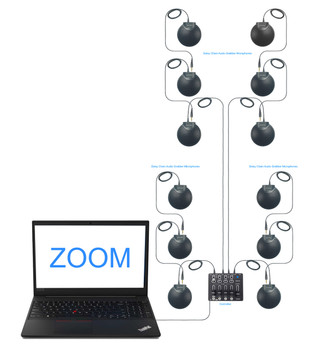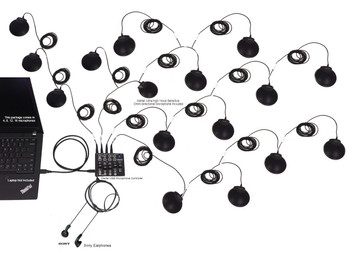Video Conferencing
Video Conferencing Microphones
-
On Sale

USB Omnidirectional Stereo Conference Microphone for PC speakerphones - with Daisy Chain Option, Condenser Mic for Teleconferencing
Martel Electronics
MSRP: $999.99Now: $599.99Was: $799.998 Microphone multiple people speaking at once for meetings, teleconferencing, video conferencing, Zoom, SKYPE, VoIP (Voiceover Internet Protocol) Calls THIS IS A MICROPHONE SYSTEM ONLY - WORKS WITH THE SPEAKERS YOU ALREADY HAVE. This item is...5981MSRP: $999.99Now: $599.99Was: $799.99 -
On Sale

360 Conference Microphones for Zoom Skype Hangout Meeting
Martel Electronics
MSRP: $799.99Now: $599.99Was: $999.99360 Conference Microphones for Zoom Skype Hangout Meeting #1 Selling Zoom Turnkey USB Multiple Microphones System in the World! NOTE: We apologize for the shortage of the Zoom multiple microphone systems. We are making every effort to meet...5982MSRP: $799.99Now: $599.99Was: $999.99 -
On Sale

Conference\meeting microphone for speakerphone for hybrid meetings
Martel Electronics
MSRP: $1,199.99Now: $799.99Was: $999.99Conference\meeting microphones for speakerphone for hybrid meetings This item sells out fast. Enter your email in the pink box, and we’ll alert you when it’s back in stock. Limited supply! 12 powerful microphones plugging into one USB input...5871MSRP: $1,199.99Now: $799.99Was: $999.99 -
On Sale

Conference Meeting Microphones for speakerphones kit for Zoom
Martel Electronics
MSRP: $999.99Now: $599.99Was: $799.99360° Omnidirectional Stereo Conference Microphone for PC - with Daisy Chain Option, Condenser Mic for Teleconferencing Conference Meeting Microphones Video Teleconferencing for Zoom, this is a microphone system only! This item is selling out...5983MSRP: $999.99Now: $599.99Was: $799.99 -

Conference Room Meeting Conference USB Microphone Kit 16 Microphones daisy chain
Martel Electronics
Sale Price $999.99Conference room meeting Conference USB Microphone Kit 16 Microphones daisy chain NOTE: We apologize for the shortage of the Zoom multiple microphone systems. We are making every effort to meet the enormous demand. The quantity will be...4291Sale Price $999.99 -
On Sale

Zoom USB Multiple 8 Microphones System
Martel Electronics
MSRP: $999.99Now: $599.99Was: $799.99#1 Selling Zoom USB Multiple 8 Microphones System for hybrid meetings in the World! This item selling out fast. Enter your email in the pink box, and we’ll alert you when it’s back in stock. Limited supply! The Ultimate Multiple Microphones...5988MSRP: $999.99Now: $599.99Was: $799.99 -
On Sale

Conference Room Microphones for Hybrid Meetings
Martel Electronics
MSRP: $999.99Now: $599.99Was: $799.99#1 Selling Zoom Turnkey USB Multiple 8 Microphones System in the World! This item is selling out fast. Enter your email in the pink box, and we’ll alert you when it’s back in stock. Limited supply! A multiple Zoom...59888MSRP: $999.99Now: $599.99Was: $799.99
